Bike hub parking facilities, UK
Supported by backing from government, a quiet revolution has seen an increase in cycling across the UK and Ireland. Although the uptake is higher in certain concentrated areas of the South East, almost all major railway stations have reasonable bike parking facilities.
The UK government wants cycling and walking to become the norm by 2040 and will target funding at innovative ways to encourage people onto a bike or to use their own two feet for shorter journeys. Plans include specific objectives to double cycling, reduce cycling accidents and increase the proportion of 5 to 10 year-olds walking to school to 55% by 2025.
£101 million has been promised to improve cycling infrastructure and expand cycle routes between city centres, local communities, and key employment and retail sites. In addition to this, it is already apparent that things are changing on the ground. Cycling rates are rising across the UK with a 23% rise in miles cycled today in comparison to 10 years ago. There is however a lot more that needs to be done, UK still lags far behind our European counterparts. One of the noticeable changes is the integration of cycle parks next to public transport, particularly railway stations.



These cycle hubs are ideal for travellers who need to combine different modes of transport, train, bus and bike. Many of the rail operators are creating a network of bespoke cycle hubs alongside stations that are part of their network, mimicking their practices from countries such as the Netherlands.
The hubs offer secure sheltered parking for bikes and include a whole host of facilities:
- CCTV
- key fob entry
- help points
- enhanced lighting
- two tiered user friendly assisted cycle
- parking racks
- biometric security.



One interesting theme throughout many of the new hubs is the use of galvanized steel. Its historical use within the support equipment is now being reflected within the structures built around the parking equipment.
Its inherent benefits make it an easy choice as a means of protection for steelwork:
- durability – long term corrosion protection with a 50 year plus of maintenance free life
- toughness – ability to withstand the daily wear and tear and constant loading and unloading of bikes
- sacrificial protection – self healing abilities of the coating in areas of damage.

